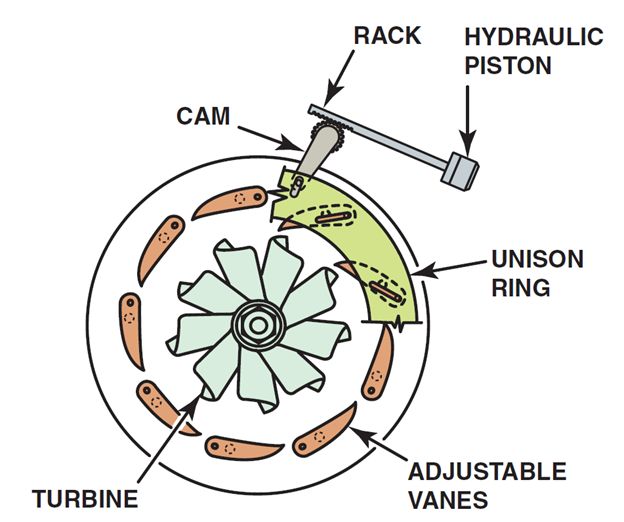Background
A variable turbocharger is used on many diesel engines for boost control. Boost pressure is controlled independent of engine speed and a wastegate is not needed. The adjustable vanes mount to a unison ring that allows the vanes to move. As the position of the unison ring rotates, the vanes change angle.
The vanes are opened to minimize flow at the turbine and exhaust back pressure at low engine speeds. To increase turbine speed, the vanes are closed. The velocity of the exhaust gases increases, as does the speed of the turbine. The unison ring is connected to a cam that is positioned by a rack-and-pinion gear. The vane position actuator solenoid connects to a hydraulic piston, which moves the rack to rotate the pinion gear and cam.
The turbocharger vane position control solenoid valve is used to advance the unison ring’s relationship to the turbine and thereby articulate the vanes. This solenoid actuates a spool valve that applies oil pressure to either side of a piston. Oil flow has three modes: apply, hold, and release.
- Apply moves the vanes toward a closed position.
- Hold maintains the vanes in a fixed position.
- Release moves the vanes toward the open position.

The following figure shows a variable vane turbocharger, which allows the boost to be controlled without the need of a wastegate.
The turbocharger vane position actuation is controlled by the ECM, which can change turbine boost efficiency independent of engine speed. The ECM provides a control signal to the valve solenoid along with a low-side reference. A pulse-width-modulated signal from the ECM moves the valve to the desired position.
Next Steps towards ASE Certification
Now that you’re familiar with Variable Vane Turbochargers, try out our free Automotive Service Excellence Tests to see how much you know!
![ASE Certification Training HQ - Free ASE Practice Tests [Updated 2021]](https://asecertificationtraining.com/wp-content/themes/simplefolio/images/ASE Certification Logo.png)
